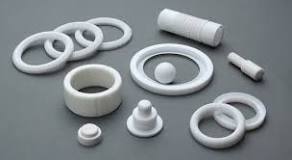Maximizing the Performance of Your PTFE Rotary Shaft Seals
PTFE (Polytetrafluoroethylene) rotary shaft seals are known for their durability and efficiency in extreme conditions. Whether you’re working in automotive, aerospace, or industrial sectors, understanding how to maximize the performance of these seals can save time, reduce costs, and improve operational efficiency. This practical guide covers the essential factors that influence the performance of PTFE rotary shaft seals and the environments in which they excel.
WHY PTFE ROTARY SHAFT SEALS ARE ESSENTIAL FOR HIGH-PERFORMANCE MACHINERY
1. Understanding Mating Surface Requirements
The surface over which the PTFE seal operates is crucial for its longevity and efficiency.
- Surface Finish: Ensure the surface finish is within the recommended range (2 to 16 RMS). Too rough, and the seal wears out quickly; too smooth, and it can’t form the necessary PTFE film. For cryogenic applications, aim for a finish of 2 to 4 RMS.
- Surface Hardness: A harder surface reduces friction and wear. For low to moderate motion, a hardness of 40 RC is sufficient. For high-speed rotary motion, opt for 55 RC to 65 RC.
SEALS IN SPACE: THE UNSUNG HEROES OF ROCKETRY
🔬 THE FASCINATING JOURNEY OF POLYTETRAFLUOROETHYLENE (PTFE) 🧪
2. Choosing the Right Material and Surface Treatment
Selecting appropriate materials and treatments enhances the performance of PTFE seals.
- Materials: Stainless steel (440C or 17-4) is commonly used. These materials achieve the necessary hardness through heat treatment.
- Surface Treatments: Treatments like electroless nickel plating or gas nitriding improve surface hardness, crucial for seal effectiveness. For example, gas nitriding can achieve up to 70 RC hardness.
🚀ADVANCED SEALS FOR CRYOGENIC HYPERGOLIC BIPROPELLANTS
3. Selecting the Right Seal for Your Application
Advanced EMC Technologies offers various PTFE seal designs to meet different operational needs:
- Series A Seal: Ideal for moderate conditions, handling pressures up to 75 psi.
- Series B Seal: Suited for higher pressure applications, up to 125 psi, providing additional protection against contaminants.
- Series C Seal: Spring-loaded for better sealing under shaft misalignment, perfect for submersible pumps.
- Series D Seal: Best for conditions with shaft runout or misalignment, maintaining effectiveness during long-term storage.
- Series E Seal: Capable of withstanding pressures up to 400 psi in lubricating media, designed for high-speed operations.
A COMPREHENSIVE GUIDE TO AEROSPACE SEALS
4. Adapting to Operating Conditions
PTFE seals are versatile, handling various temperatures and pressures:
- Temperature Range: Operate effectively from cryogenic conditions (-450°F) to high temperatures (500°F).
- Pressure: Suitable for high-pressure environments up to 500 psi, ideal for hydraulic systems.
THE REVOLUTIONARY IMPACT OF PTFE ROTARY SHAFT SEALS ON INDUSTRIAL APPLICATIONS
5. Ensuring Media Compatibility
PTFE’s chemical inertness ensures it can seal a variety of aggressive media, making it suitable for applications involving steam, corrosive chemicals, and other harsh media. Here are some examples of environments where PTFE rotary shaft seals excel:
- Steam Environments: PTFE seals are commonly used in steam turbines and autoclaves. For example, in power generation plants, PTFE seals ensure reliable performance by resisting high-temperature steam and preventing leaks.
- Chemical Processing Plants: In environments where corrosive chemicals like sulfuric acid, hydrochloric acid, and sodium hydroxide are used, PTFE seals provide excellent resistance. For instance, in chemical reactors and storage tanks, these seals prevent leaks and maintain the integrity of the system.
- Pharmaceutical and Food Industries: PTFE’s compatibility with various solvents makes it ideal for mixers and pumps. In pharmaceutical manufacturing, PTFE seals prevent contamination during the processing of active ingredients and solvents. Similarly, in the food industry, they ensure sanitary conditions by resisting cleaning agents and maintaining seal integrity.
- Aerospace Applications: PTFE seals are utilized in aircraft engines and space vehicles due to their ability to withstand extreme temperatures and pressures. For example, in rocket engines, PTFE seals maintain performance under the harsh conditions of space travel, including exposure to cryogenic fuels and high-speed rotation.
- Oil and Gas Industry: PTFE seals are used in drilling equipment and pipelines, where they encounter high pressures and aggressive media like crude oil and natural gas. These seals ensure reliable operation and prevent leaks in high-stakes environments.
ADVANCED PROPERTIES AND APPLICATIONS OF PTFE IN SEALING TECHNOLOGY
6. Utilizing Fluoropolymer Material Enhancements
Enhance PTFE performance by selecting the right filler material:
- Unfilled PTFE: Low friction, ideal for food and pharmaceutical applications, and cryogenic conditions.
- Glass-Filled PTFE: Adds strength but can be abrasive. Best for harder surfaces.
- Molybdenum Disulfide-Filled PTFE: Improves wear resistance without being too abrasive, suitable for softer shafts.
- Carbon-Filled PTFE: Excellent for high-temperature, high-pressure environments, providing natural lubrication.
- Polyimide-Filled PTFE: Enhances creep resistance, ideal for compressor rings and similar applications.
INTRODUCTION TO PTFE LIP SEALS
Maximizing the performance of PTFE rotary shaft seals involves understanding and optimizing several factors, including the mating surface characteristics, material selection, and operating conditions. By selecting the appropriate seal design and ensuring media compatibility, you can significantly enhance the reliability and lifespan of your seals in various demanding environments.
For more information on PTFE rotary shaft seals and to explore Advanced EMC Technologies’ offerings, visit Advanced EMC Technologies.


